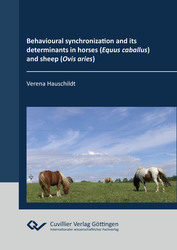| Departments | |
|---|---|
| Book Series (96) |
1378
|
| Nachhaltigkeit |
3
|
| Gesundheitswesen |
1
|
| Humanities |
2364
|
| Natural Sciences |
5406
|
| Mathematics | 229 |
| Informatics | 319 |
| Physics | 980 |
| Chemistry | 1363 |
| Geosciences | 131 |
| Human medicine | 243 |
| Stomatology | 10 |
| Veterinary medicine | 108 |
| Pharmacy | 147 |
| Biology | 835 |
| Biochemistry, molecular biology, gene technology | 121 |
| Biophysics | 25 |
| Domestic and nutritional science | 45 |
| Agricultural science | 1004 |
| Forest science | 201 |
| Horticultural science | 20 |
| Environmental research, ecology and landscape conservation | 148 |
| Engineering |
1793
|
| Common |
98
|
|
Leitlinien Unfallchirurgie
5. Auflage bestellen |
|
Advanced Search
Behavioural synchronization and its determinants in horses (Equus caballus) and sheep (Ovis aries) (English shop)
Verena Hauschildt (Author)Preview
Table of Contents, PDF (51 KB)
Extract, PDF (93 KB)
Socially organized animals have to synchronize the timing and directions of their movement decisions, in order to maintain group cohesion. To what extent social and environmental mechanisms trigger behavioural synchronization is still poorly understood. When housing management restricts space availability or predetermines feeding schedules, synchronization may develop as a random phenomenon due to external cues.
This thesis investigated social and environmental determinants of behavioural synchronization in horses and sheep. Deeper understanding of what constitutes behavioural synchronization is essential in order to adequately classify behavioural changes related to synchronization, and to furthermore enable predictions of management problems in group housing of animals.
| ISBN-13 (Hard Copy) | 9783736991019 |
| ISBN-13 (eBook) | 9783736981010 |
| Final Book Format | A5 |
| Language | English |
| Page Number | 172 |
| Lamination of Cover | matt |
| Edition | 1. Aufl. |
| Publication Place | Göttingen |
| Place of Dissertation | Göttingen |
| Publication Date | 2015-09-15 |
| General Categorization | Dissertation |
| Departments |
Agricultural science
|
| Keywords | horses, sheep, synchronization, cohesion, social structure, spacing, plot size, aerial photography, gregariousness, kappa coefficient |








